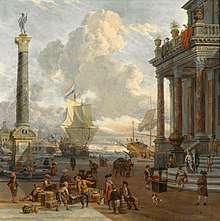Foreign trade of Pakistan
Pakistan has bilateral and multilateral trade agreements with many nations and international organizations. It is a member of the World Trade Organization, part of the South Asian Free Trade Area agreement and the China–Pakistan Free Trade Agreement. Fluctuating world demand for its exports, domestic political uncertainty, and the impact of occasional droughts on its agricultural production have all contributed to variability in Pakistan's trade deficit. The trade deficit for the fiscal year 2013/14 is $7.743 billion, exports are $10.367 billion in July–November 2013 and imports are $18.110 billion.[1]
| Part of a series on |
| World trade |
|---|
 |
|
Economic integration
|
| Part of a series on |
| World trade |
|---|
 |
|
Economic integration
|
Pakistan's exports continue to be dominated by men power export in the subcontinent,cotton textiles and apparel. Imports include petroleum and petroleum products, chemicals, fertilizer, capital goods, industrial raw materials, and consumer products.
On 12 December 2013, the European Union granted GSP Plus status to Pakistan[2] until 2017, which enabled it to export 20% of its good with 0 tariff and 70 percent at preferential rates to the EU market. This status was given after the European Parliament passed the resolution by 406-186 votes.[3]
Exports
Pakistan's exports for the year 2015-2016 stood at US$21 Billion and imports were at US$44.76 billion for the same period.[4]
Pakistan's exports increased more than 100% from $7.5 billion in 1999 to stand at $18 billion in the financial year 2007–2008.[5][6]
Pakistan exports rice, kinnows, mangoes, furniture, cotton fiber, cement, tiles, marble, textiles, clothing, leather goods, veterinary surgical supplies, sports goods (renowned for footballs/soccer balls), cutlery, surgical instruments, electrical appliances, software, carpets, rugs, ice cream, livestock meat, chicken, powdered milk, wheat, seafood (especially shrimp/prawns), vegetables, processed food items, Pakistani-assembled Suzukis (to Afghanistan and other countries), defense equipment (submarines, tanks, radars), salt, onyx, engineering goods, and many other items. Pakistan produces and exports cements to Asia and the Middle East. In August 2007, Pakistan started exporting cement to India to fill in the shortage there caused by the building boom.[7] Russia is a growing market for Pakistani exporters. In 2009/2010 the export target of Pakistan was US$20 billion.[8] As of April 2015, Pakistan's exports stand at US$29 billion.
List of trading partners
The following is a list of Pakistan's main trading partners as of JULY 2017.
| Country | Percentage of imports | Percentage of exports | Percentage of total trade |
|---|---|---|---|
| 31 | 11 | 16.9 | |
| 10.4 | 18.2 | 13.0 | |
| 12.1 | 8.5 | 10.9 | |
| 12.2 | 8.5 | 9.0 | |
| 3.7 | 13.6 | 6.7 | |
| 6.3 | 0.07 | 4.4 | |
| 4.07 | 1.67 | 3 | |
| 9 | 0.9 | 2.9 | |
| 3.6 | 1.6 | 2.9 | |
| 3.4 | 1.8 | 2.9 | |
| 0.3 | 7.6 | 2.8 | |
| 4.1 | 0.3 | 2.8 |
Companies that support Pakistan
The following is a list of companies that have business ties with Pakistan.









































































.svg.png)










.svg.png)









See also
References
- http://in.reuters.com/article/2013/12/13/pakistan-trade-idINL4N0JA23Z20131213
- Lone, Mahlia S. (30 December 2013). "Pakistan to Benefit From EU Trade Status". WWD. Retrieved 2 January 2014.
- http://www.business-standard.com/article/news-ani/pak-gets-gsp-plus-status-till-2017-for-free-access-to-eu-market-113121300203_1.html
- Arshad Hussain (July 16, 2016). "Total exports slide by 12.11% in 2015-16, imports by 2.32%". Retrieved October 3, 2017.
- "Government of Pakistan. Statistics division federal bureau of statistics. Karachi. Summary June 2007" (PDF). June 2007. Archived from the original (PDF) on June 27, 2008. Retrieved July 4, 2011.
- "Data: Board of Investment " Economic Pakistan". Economicpakistan.wordpress.com. 2008-02-18. Retrieved 2010-07-29.
- "Pakistan to start cement export by August end" Archived August 21, 2007, at the Wayback Machine, Yahoo! News, August 3, 2007
- http://www.freshplaza.com/news_detail.asp?id=66884
External links
- Trade and Payments
- SMB Marble
- Pakistan Trade
- "A statistical look into Pakistan's foreign friendships". The Express Tribune. 3 May 2015. Retrieved 4 May 2015.
